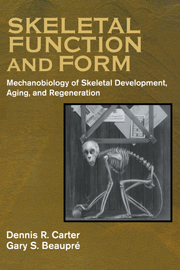Book contents
- Frontmatter
- Contents
- Preface
- Chapter 1 Form and Function
- Chapter 2 Skeletal Tissue Histomorphology and Mechanics
- Chapter 3 Cartilage Differentiation and Growth
- Chapter 4 Perichondral and Periosteal Ossification
- Chapter 5 Endochondral Growth and Ossification
- Chapter 6 Cancellous Bone
- Chapter 7 Skeletal Tissue Regeneration
- Chapter 8 Articular Cartilage Development and Destruction
- Chapter 9 Mechanobiology in Skeletal Evolution
- Chapter 10 The Physical Nature of Living Things
- Appendix A Material Characteristics
- Appendix B Structural Characteristics
- Appendix C Failure Characteristics
- Index
Chapter 6 - Cancellous Bone
Published online by Cambridge University Press: 11 January 2010
- Frontmatter
- Contents
- Preface
- Chapter 1 Form and Function
- Chapter 2 Skeletal Tissue Histomorphology and Mechanics
- Chapter 3 Cartilage Differentiation and Growth
- Chapter 4 Perichondral and Periosteal Ossification
- Chapter 5 Endochondral Growth and Ossification
- Chapter 6 Cancellous Bone
- Chapter 7 Skeletal Tissue Regeneration
- Chapter 8 Articular Cartilage Development and Destruction
- Chapter 9 Mechanobiology in Skeletal Evolution
- Chapter 10 The Physical Nature of Living Things
- Appendix A Material Characteristics
- Appendix B Structural Characteristics
- Appendix C Failure Characteristics
- Index
Summary
Biology and Morphology
Cancellous bone in the metaphyseal and epiphyseal regions is derived primarily through endochondral ossification. The endochondral ossification process described in Chapter 5 leads to the calcification of cartilage extracellular matrix around the hypertrophic chondrocytes. The spatial patterns of the terminal, hypertrophic chondrocytes in the matrix determine the textural pattern of matrix calcification. In humans, the newly calcified cartilage is quickly resorbed by chondroclasts, creating small erosion bays in which osteoblasts immediately form bony trabeculae. The initial architecture of the cancellous bone that is formed is thus dictated by the organization of the cells and calcified cartilage that precede bone formation.
The histomorphologic organization of the hypertrophic chondrocytes can vary considerably, and therefore the initial architecture of the cancellous bone can be quite different in different regions and in different taxa (as will be considered in Chapter 9). For example, the primary growth front in mammals tends to be organized into columns of maturing and hypertrophying chondrocytes. The hypertrophying chondrocytes around the secondary ossific nucleus, however, are relatively unorganized (Farnum and Wilsman, 1998). Consequently, the initial bone structure in the metaphysis is organized into fine columns of interconnecting trabeculae, and the initial cancellous bone in the epiphysis appears to have thicker trabeculae and a more random appearance. As the secondary ossification center expands and the subchondral growth front approaches the joint surface, the chondrocytes become more organized into columns. Newly formed subchondral cancellous bone therefore tends to be organized with a principal trabecular orientation that is perpendicular to the joint surface.
Information
- Type
- Chapter
- Information
- Skeletal Function and FormMechanobiology of Skeletal Development, Aging, and Regeneration, pp. 138 - 160Publisher: Cambridge University PressPrint publication year: 2000
